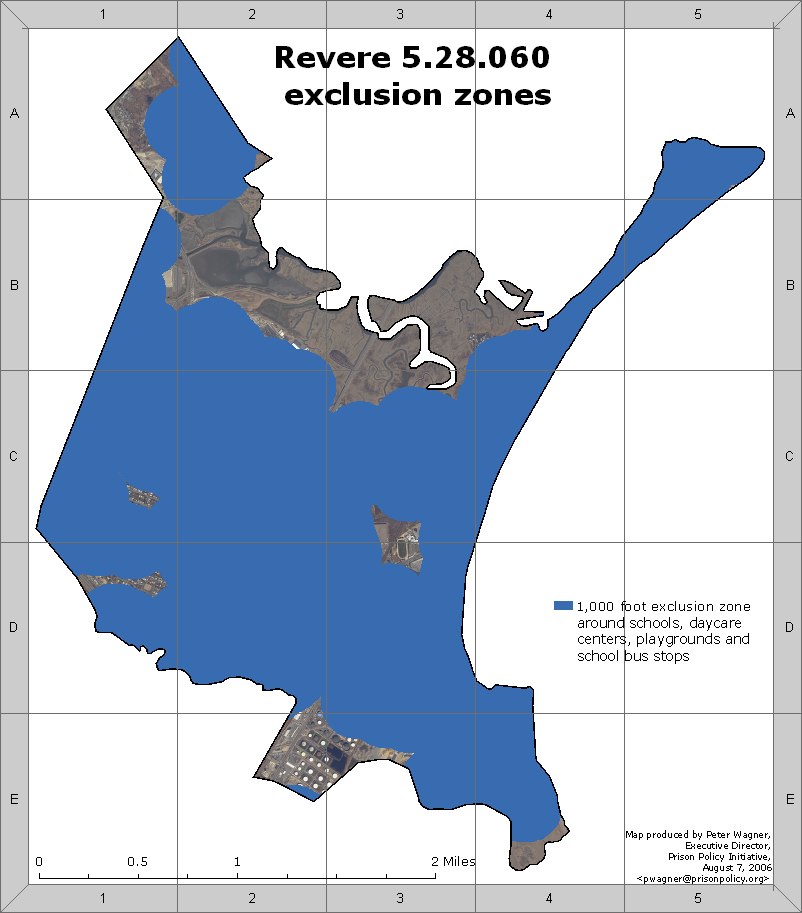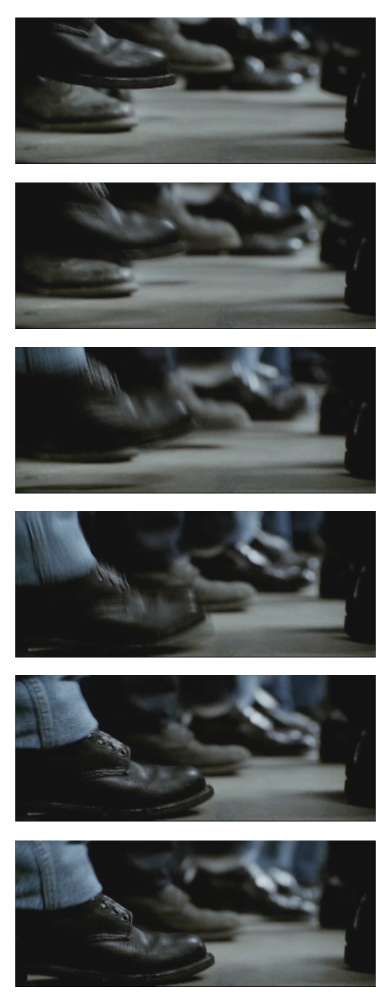The New York Times quotes Executive Director Peter Wagner in "Panel recommends change in how prisoners are counted in U.S. Census".
by Peter Wagner,
September 15, 2006

The New York Times quotes Executive Director Peter Wagner in Panel recommends change in how prisoners are counted in U.S. Census.
by Peter Wagner,
September 6, 2006
Added Ezekiel Edwards’ article Counting Off Upstate: Just Say Moo, in The Brooklyn Rail to the PPI in the News page.
by Peter Wagner,
August 25, 2006
Our worked is cited in a New York Newsday editorial We’re a long way from real democracy.
Affidavit prepared by Peter Wagner for a Revere, Massachusetts case regarding a city ordinance that would banish a person classified as a level 3 sex offender from the city.
by Peter Wagner,
August 14, 2006
This affidavit was prepared for a case in Revere Massachusetts where the city was preparing to enforce a city ordinance that would banish a person classified as a level 3 sex offender from the city. The clerk-magistrate declined to issue a complaint and the prosecution did not proceed.
Affidavit of Peter Wagner
1. I, Peter Wagner, am an attorney and Executive Director of the Prison Policy Initiative a non-profit research organization based in Easthampton, Massachusetts. The Prison Policy Initiative focuses on the intersection of criminal justice policy and other social issues. In my role as Executive Director, I regularly make maps and analyze Census data.
2. In March 2004, I gave an invited presentation of my research at “America’s Scorecard: The Census in an Ever-Changing Nation”, an academic symposium organized by the Census Bureau in Washington D.C., and in June 2005 I gave an invited presentation to a panel of the National Academy of Sciences investigating Census Bureau methodology.
3. I am currently leading a project at the Prison Policy Initiative that involves mapping 1,000 foot zones around urban and rural schools in Hampden County and then analyzing the Census populations of the affected areas.
4. On July 12, 2006, I testified in the United States District Court for the Northern District of Georgia in Whitaker v. Perdue (4:06-cv-00140-CC) in support of plaintiff’s motion for a preliminary injunction barring enforcement of HB1059, Georgia’s Sex Offender Residence law. To prepare for my testimony, I prepared maps of 1,000 foot exclusion zones around schools, day care centers, bus stops, parks and other areas listed in the statute as places that people on the sex offender registry cannot live.
5. I used GIS technology and a software package called Arcview 9.1 to map the areas in the city of Revere which are one thousand linear feet of a public or private school, nursery school, day care center, kindergarten, and playground. The map entitled “Revere 5.28.060 exclusion zones” represents that the Revere ordinance of October 25, 2005 would prohibit level III sex offenders from living in more than 99% of the city. No more than 100 residential buildings in the City of Revere are outside of the ordinance’s exclusion zone.
6. The map “Revere 5.28.060 exclusion zones” shows that the majority of Revere is included in the exclusion zones. The majority of the remainder is industrial (grids E2, E3) Suffolk Downs (C3, D3) or marsh (B2, B3, B4, C3, E4). Most of the land in grid A1 that is not in an exclusion zone is undeveloped woodland.
7. Residential houses outside of the exclusion zone can be seen only in Grids A1, C1 and D1. However, many of the houses visible in the photographs may also be off limits to people designated as level 3 offenders for other reasons. First, the map shows the exclusion zones as measured only from a single point on the property of day care centers and schools. In reality, day care centers and schools are much larger than a single point, as they may contain multiple buildings, playing fields, etc, the exclusion zones are actually larger than they appear on the map. Second, while the aerial pictures show structures, they do not show property lines of individual residences. Many of the residential structures seen in the aerial photographs are on properties that partially extend in to the exclusion zone and are therefore off limits to people designated as level 3 offenders. The map “HB1059 exclusion reaches beyond 1,000 feet“, which I prepared for the Whitaker v. Perdue case, demonstrates the drawing simple circles with a radius of 1,000 feet understates the actual impact of the exclusion zones. Finally, aerial photography can only identify structures. It can not, by itself, confirm whether any of the remaining structures outside the exclusion zone are in fact available for rent or purchase.
8. To make these maps I used a variety of data sources:
- Schools: I used a file created by MassGIS, the Commonwealth’s Office of Geographic and Environmental Information, within the Massachusetts Executive Office of Environmental Affairs that represented each public and private school in the state as of October 18, 2004. This file does not represent the property line of each school, instead showing only one point for each school. The property lines for schools in Revere were not immediately available.
- Day Care Centers: The Massachusetts Department of Early Education and Care maintains a list of all licensed child care facilities in the state. I used the address of each facility in Revere to place single points on the map. The property lines for day care centers in Revere were not immediately available.
- Playgrounds: I downloaded the MassGIS database of Protected and Recreational Open Space (last updated February 2006) and filtered it to use only the shapes of properties that had “park” or “beach” in the title.
- Bus stops: Peter Martino at Revere Transportation Department provided a list of school bus stops which were then placed on the map.
- Aerial photography: MassGIS publishes aerial photography taken in April 2005 at the 1:5000 scale.
- The Census block maps and Revere City boundary file was created by the U.S. Census Bureau and distributed by ESRI, the manufacturer of the ArcView GIS program.
9. On August 10, 2006, I learned that the City of Revere had amended ordinance 5.28.060 to restrict people classified as a level 3 from living within 1,000 feet of schools. Based with this information, I made a new map and then overlaid the 1,000 foot exclusion zones over Census Bureau data to determine that at least 4,400 housing units in Revere are now off limits to people classified as level 3 sex offenders. This is 21.8% of the housing units in Revere. Those housing units contain at least 10,252 people, or 21.7% of the city.
10. According to the U.S. Census, in 2000 Revere had 47,283 people and 20,181 housing units. The use of Census Bureau data from 2000 is appropriate for three reasons. First, the decennial census is the only reliable source of block level data. Second, Census Bureau estimates for the entire city show that the population has been relatively stable from 2000 to the most recent estimates in July 2003. The population of Revere in July 2003 was estimated to be 47,002, or only 0.6% smaller. Third, the aerial photography from 2005 shows that there are no new large housing developments outside of the exclusion zones. The unpopulated marsh and industrial areas in Revere remained uninhabitable.
11. As in Paragraph 7, this methodology also understates the impact of the exclusion zones because I used the point of each school’s address rather than its actual border. Schools are significantly larger than a single point, as a school may contain several buildings, playgrounds and other land. Secondly, this methodology also understates the impact of the Revere ordinance because I was unable to show the property lines of individual residences in Revere.
12. Therefore, the fact that at least 4,400 housing units in Revere are off limits to people classified as a level 3 should be seen as only a minimal figure. The actual number of housing units off limits under this ordinance can not be lower than 4,400, but it may be higher.
Signed under the pains and penalties of perjury this 14 day of August, 2006.
Peter Wagner

David Feige's new chronicles one day in the life of a public defender in the South Bronx.
by Peter Wagner,
June 19, 2006

David Feige’s great new book, Indefensible : One Lawyer’s Journey into the Inferno of American Justice came out two weeks ago. Written by the former trial chief of the Bronx Defenders, Indefensible chronicles one day in the life of a public defender in the South Bronx. It’s a fast, exciting and very important book.
Read the book and David’s blog today.
Letter to the editor in the Hampshire Gazette by Peter Wagner arguing against a $6 million expansion to the Hampden County women's jail.
by Peter Wagner,
April 27, 2006
Published in the Daily Hampshire Gazette (Northampton, MA) April 27, 2006
To the editor:
Hampden County Sheriff Michael Ashe says his new women’s jail will be full
when it opens next year, so he wants another $6 million to add 56 more
cells. Our local leaders should say no. The new women’s jail will hold women
from all four counties of western Massachusetts.
Building bigger jail after bigger jail is not the solution to crime and it
might even make things worse. Adding extra capacity to a jail should be a
last resort, because those empty cells will reduce the pressure for judges
and legislators to consider cost-effective and rehabilitative alternative
sentences for people who pose no threat to the community.
Rather than build now, the prudent thing to do is to force Sheriff Ashe to
”make do” for a few years with the 240 cells already under construction.
Before lawmakers grant Ashe’s request, they should remember that 56 cells
will cost $2.4 million a year to operate. That money will no longer be
available to fund schools, drug treatment or other far more beneficial
programs.
Bringing more state investment to western Massachusetts is a good goal, but
dumping it into jails is the last thing we can afford.
Peter Wagner
Northampton
Johnny Cash condemns the corruption and brutality of prisons in the song "Jacob Green".
by Peter Wagner,
December 22, 2005

Frames from the Johnny Cash biopic. Note the missing shoelaces.
There is a new movie about Johnny Cash in the theatres now, Walk the Line. The trailer explains the importance of the film better than I can here, so I’ll let the trailer and the frames on the right of prisoners stomping their feet for Johnny Cash speak for themselves about the film.
This is as good a time as any to revisit our last article about Johnny Cash. When he died in 2003, we replaced the front page of this website with an obituary that highlighted what we then thought were two of his least known and most important songs, Man in Black and San Quentin.
Since then, we’ve discovered something rarer and even more important: Jacob Green. The song was first performed at a Swedish prison and released on the 1974 LP “Pa Osteraker” (Inside a Swedish Prison). In the U.S., the only place we know of to hear or see this song is in the recording of a 1976 concert at the Tennessee State Prison, A Concert Behind Prison Walls.
From that recording, here are the lyrics to Jacob Green:
Jacob Green
I’ve learned one thing, that when a man is at rock bottom, when there is no place else he can go except up, that the only thing that is really important in the world to him is that somebody, somewhere cares. And with that in mind, I wrote this song about something that really happened to a 16 year old boy in the state of Virginia. It’s called Jacob Green.
Jacob Green got busted for possession
next morning early he appeared in court
But he was sent to jail to wait
to be tried at some later date
Next morning early, there came a sad report
At the jail they took away his clothes to shame him
and to make sure Jacob Green had no pride left
They cut of all his hair
Today they found him hanging there
afraid to face the day he killed himself
It happened yesterday, and if you turn your head away
Somewhere in some dirty hole the scene will be rerun
Not only Jacob Green, but many more you’ve never seen
It could be someone that you love gets done
like Jacob Green got done
It could be someone that you love gets done
like Jacob Green got done
Jacobs father hired a team of lawyers
inspections and long inquiries were held
The sheriff then retired
and the papers said two guards were fired
They put a brand new coat of paint on Jacob’s cell
But like a tomb that looks so white and shiny
inside you’ll find corruption never seen
And somewhere out there tonight
In a dirty cell without a light
There will be locked up another Jacob Green
It happened yesterday, and if you turn your head away
Somewhere in some dirty hole the scene will be rerun
Not only Jacob Green, but many more you’ve never seen
It could be someone that you love gets done
like Jacob Green got done
It could be someone that you love gets done
like Jacob Green got done
The European Court rules that the disenfranchisement of 48,000 convicts in British jails violates the European convention on human rights.
by Peter Wagner,
October 6, 2005
UK prisoners should get vote, European court rules
Simon Jeffery
Thursday October 6, 2005
“Laws setting out who can and cannot take part in elections are to be rewritten after the European court of human rights today ruled in favour of giving British prisoners the right to vote.
“Ruling in the case of a former prisoner against the United Kingdom, the Strasbourg court said the disenfranchisement of 48,000 convicts in British jails violated the European convention on human rights.
“It said that with the exception of the right to liberty, lawfully detained prisoners continued to enjoy all the rights guaranteed in the convention – including political rights and freedom from inhumane and degrading punishment.” ….
See the full story on the Guardian website.
Thank you to Rick Lines at the Irish Penal Reform Trust for the heads up about this exciting news.
As Hurricane Katrina began pounding New Orleans, the sheriff's department abandoned hundreds of inmates imprisoned in the city's jail.
by Peter Wagner,
September 23, 2005
Officers Deserted a Jail Building, Leaving Inmates Locked in Cells
(New York, September 22, 2005)–
As Hurricane Katrina began pounding New Orleans, the sheriff’s department abandoned hundreds of inmates imprisoned in the city’s jail, Human Rights Watch said today.
Inmates in Templeman III, one of several buildings in the Orleans Parish Prison compound, reported that as of Monday, August 29, there were no correctional officers in the building, which held more than 600 inmates. These inmates, including some who were locked in ground-floor cells, were not evacuated until Thursday, September 1, four days after flood waters in the jail had reached chest-level.
“Of all the nightmares during Hurricane Katrina, this must be one of the worst,” said Corinne Carey, researcher from Human Rights Watch. “Prisoners were abandoned in their cells without food or water for days as floodwaters rose toward the ceiling.”
Read the rest from Human Rights Watch.

 Added press release announcing that
Added press release announcing that 





